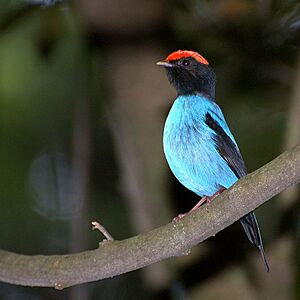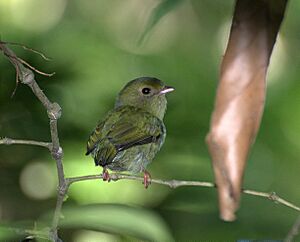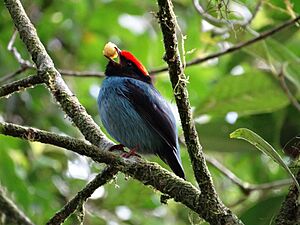Blue manakin facts for kids
Quick facts for kids Blue manakin |
|
|---|---|
 |
|
| Male | |
 |
|
| Female | |
| Conservation status | |
| Scientific classification | |
| Genus: |
Chiroxiphia
|
| Species: |
caudata
|
| Synonyms | |
|
Pipra caudata (basionym, Shaw & Nodder, 1793) |
|
The blue manakin (Chiroxiphia caudata) is a small, colorful bird. It belongs to the Pipridae family. You can find it mainly in the Atlantic Forest. This forest stretches across south-eastern Brazil, eastern Paraguay, and parts of north-eastern Argentina.
Blue manakins live in wet lowland or mountain forests. They can also be found in areas where forests used to be. Male blue manakins are very striking. They have a bright blue body, black head, wings, and tail. A small red cap sits on top of their head. Females and young birds are a duller olive-green color.
During breeding season, males perform special dances. They sing and dance together to attract females. This behavior is called lekking. The blue manakin is a common bird. Its population is stable. Because of this, the International Union for Conservation of Nature says it is a "least concern" species. This means it is not currently at risk of extinction.
Contents
Where Do Blue Manakins Live?
This amazing bird lives in several South American countries. You can find it in north-eastern Argentina, southern and south-eastern Brazil, and Paraguay. Its favorite places to live are forests. These include subtropical or tropical moist lowland forests and montane forests. They also live in areas where forests have been changed by people.
Blue manakins are quite common in these areas. They prefer habitats that are moist and warm.
Male blue manakins live in small groups. Usually, one to five males share an area. This area is about 100 square meters. In each group, there is an "alpha" male. He is the leader. There is also a "beta" male and a few "gamma" males.
Each group has special display spots. These are usually horizontal vines or branches. They are about one meter off the ground. The alpha and beta males keep these spots clean. They remove leaves, moss, and twigs. This makes the display area look neat and white.
What Do Blue Manakins Look Like?
The blue manakin is a small bird. It is about 15 cm (5.9 in) long. It weighs around 25.6 g (0.90 oz). This makes it one of the larger birds in the manakin family.
The male blue manakin is very colorful. Its whole body is a bright, shiny blue. Its wings, tail, and head are black. But it has a bright red cap on its head! The female is much duller. She is mostly greenish-brown. Both males and females have longer central tail feathers.
How Do Young Males Change?
Young male blue manakins look like the adult females. They are greenish-brown at first. Slowly, they start to change. First, they get their red cap. Then, their face sides turn black. Finally, the rest of their feathers become bright blue. This transformation takes time.
Why Do Males Dance?
Male blue manakins are famous for their "lekking" behavior. A lek is a special gathering place. Here, males sing and dance together. They do this to attract females. A typical lek has one adult male and two younger males.
Their dances are quite impressive! They move and sing to show off. This was even shown in the BBC documentary The Life of Birds. However, not all males get to mate. In fact, up to 90% of male blue manakins may never find a mate. This is because females are very picky!
Are Blue Manakins Safe?
The blue manakin has a very large home range. It is also a common bird. Scientists believe there are many blue manakins in total. The number of these birds seems to be steady.
Because of its wide range and stable numbers, the International Union for Conservation of Nature has given it a "least concern" status. This means the blue manakin is not currently in danger. It is not considered a threatened species.



